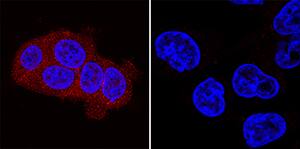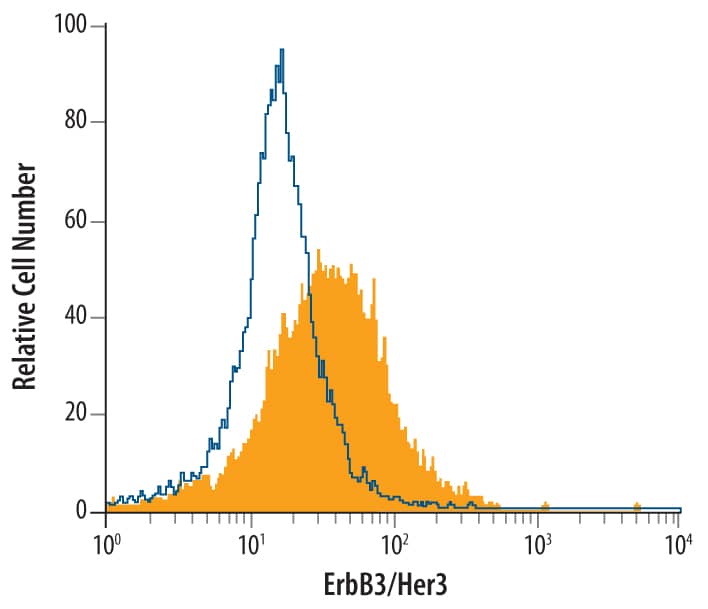Mouse ErbB3/Her3 Antibody
R&D Systems, part of Bio-Techne | Catalog # AF4518

Key Product Details
Species Reactivity
Applications
Label
Antibody Source
Product Specifications
Immunogen
Ser20-His641
Accession # Q61526
Specificity
Clonality
Host
Isotype
Scientific Data Images for Mouse ErbB3/Her3 Antibody
Detection of ErbB3/Her3 in C2C12 Mouse Cell Line by Flow Cytometry.
C2C12 mouse myoblast cell line was stained with Sheep Anti-Mouse ErbB3/Her3 Antigen Affinity-purified Polyclonal Antibody (Catalog # AF4518, filled histogram) or control antibody (Catalog # 5-001-A, open histogram), followed by Allophycocyanin-conjugated Anti-Sheep IgG Secondary Antibody (Catalog # F0127).ErbB3/Her3 in MCF‑7 and MDA‑MD‑231 Human Cell Lines.
ErbB3/Her3 was detected in immersion fixed MCF-7 human breast cancer cell line (left panel) and MDA-MD-231 human breast cancer cell line (right panel) using Sheep Anti-Mouse ErbB3/Her3 Antigen Affinity-purified Polyclonal Antibody (Catalog # AF4518) at 5 µg/mL for 3 hours at room temperature. Cells were stained using the NorthernLights™ 557-conjugated Anti-Sheep IgG Secondary Antibody (red; Catalog # NL010) and counterstained with DAPI (blue). Specific staining was localized to cytoplasm. View our protocol for Fluorescent ICC Staining of Cells on Coverslips.ErbB3/Her3 in Embryonic Mouse Dorsal Root Ganglion.
ErbB3/Her3 was detected in immersion fixed frozen sections of embryonic mouse dorsal root ganglion (E10.5) using 10 µg/mL Sheep Anti-Mouse ErbB3/Her3 Antigen Affinity-purified Polyclonal Antibody (Catalog # AF4518) overnight at 4 °C. Tissue was stained with the NorthernLights™ 557-conjugated Anti-Sheep IgG Secondary Antibody (red; Catalog # NL010) and counterstained with DAPI (blue). View our protocol for Fluorescent IHC Staining of Frozen Tissue Sections.Applications for Mouse ErbB3/Her3 Antibody
CyTOF-ready
Flow Cytometry
Sample: C2C12 mouse myoblast cell line
Immunocytochemistry
Sample: Immersion fixed MCF-7 human breast cancer cell line and MDA-MD-231 human breast cancer cell line
Immunohistochemistry
Sample: Immersion fixed frozen sections of embryonic mouse dorsal root ganglion (E10.5)
Western Blot
Sample: Recombinant Mouse ErbB3/Her3 Fc Chimera (Catalog # 4518-RB)
Formulation, Preparation, and Storage
Purification
Reconstitution
Formulation
Shipping
Stability & Storage
- 12 months from date of receipt, -20 to -70 °C as supplied.
- 1 month, 2 to 8 °C under sterile conditions after reconstitution.
- 6 months, -20 to -70 °C under sterile conditions after reconstitution.
Background: ErbB3/Her3
ErbB3, also called Her3 (human epidermal growth factor receptor 3) in humans, is a type I transmembrane glycoprotein that is a member of the ErbB family of tyrosine kinase receptors named for a viral oncogene (1‑3). ErbB family members serve as receptors for the EGF family of growth factors (1‑3). Mouse ErbB3 contains a 19 amino acid (aa) signal sequence, a 622 aa extracellular domain (ECD), a 24 aa transmembrane region, and a 677 aa cytoplasmic domain (4). Human ErbB3 has four isoforms created by intron read-through and truncation of the molecule (5). Three of these are secreted and at least one can inhibit ErbB3 activity (6). Little information is available concerning mouse ErbB3 isoforms. The mouse ErbB3 ECD shares 97%, 93%, 92%, 91%, 89% and 88% aa identity with rat, human, bovine, equine, canine and opossum ErbB3, respectively. ErbB3 is found in epithelial cell layers of gastrointestinal, reproductive, urinary, endocrine and nervous systems, skin and muscle (3). Among ErbB family members, only ErbB3 lacks a working kinase domain, requiring heterodimerization with another ErbB receptor for signaling (1‑3). The heterodimer of ErbB3 with ErbB2, which has no known ligands of its own, is expressed in the majority of breast, skin, ovary and gastrointestinal tumors and transduces a highly mitogenic signal in response to neuregulin 1 (NRG1; heuregulin 1) or NRG2 (3, 7‑9). These ligands also bind ErbB4 (1). Signaling is aided by the six consensus binding motifs for the SH2 domain and one for the SH3 domain of the regulatory p85 subunit of phosphoinositide 3-kinase (10, 11). Deletion studies in mice demonstrate non-redundant roles for ErbB3 in development of Schwann cells, neural crest cells and heart valves (12, 13). ErbB3, ErbB2 and neuregulin are all required for formation of the sympathetic nervous system (14).
References
- Linggi, B. and G. Carpenter (2006) Trends Cell Biol. 16:649.
- Citri, A. and Y. Yarden (2006) Nat. Rev. Mol. Cell Biol. 7:505.
- Citri, A. et al. (2003) Exp. Cell Res. 284:54.
- Swissprot Accession # Q61526.
- Lee, H. et al. (1998) Oncogene 16:3243.
- Lee, H. et al. (2001) Cancer Res. 61:4467.
- Carraway, K.L. 3rd et. al. (1994) J. Biol. Chem. 269:14303.
- Sundaresan, S. et al. (1998) Endocrinology 139:4756.
- Wallasch, C. et al. (1995) EMBO J. 14:4267.
- Hellyer, N.J. et. al. (1998) Biochem. J. 333:757.
- Hellyer, N.J. et. al. (2001) J. Biol. Chem. 276:42153.
- Riethmacher, D. et al. (1997) Nature 389:725.
- Erickson, S.L. et al. (1997) Development 124:4999.
- Britsch, S. et al. (1998) Genes Dev. 12:1825.
Long Name
Alternate Names
Gene Symbol
UniProt
Additional ErbB3/Her3 Products
Product Documents for Mouse ErbB3/Her3 Antibody
Product Specific Notices for Mouse ErbB3/Her3 Antibody
For research use only


